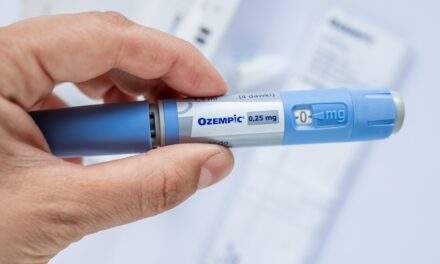It was the biggest breakthrough in diabetes care since the discovery of insulin.
A new Type 2 diabetes medication that can be used when other therapies fail. One that consistently lowers blood sugar levels and regulates insulin with just one dose a week.
Even for those without diabetes, the drug can lower the risk of heart attacks or strokes by more than 20%.
And that’s not all…
The drug imitates a unique hormone (called “glucagon-like peptide-1”) to manage insulin levels. That same hormone is responsible for managing hunger, signaling that we’re full after a meal and slowing the rate at which our stomach empties.
In other words — Novo Nordisk (NYSE: NVO), the Danish pharmaceutical company behind this innovative treatment, stumbled upon the ultimate weight loss drug.
It’s no exaggeration to say that semaglutide, which is sold under the names “Ozempic” and “Wegovy” is as close as science has come to a magic pill for dieting.
Because that same weekly injection can dramatically cut down on cravings and hunger.
It reduces what studies call “food noise,” which is that constant nagging suspicion that you should have a bag of chips in your hand.
The drug is already taking Hollywood by storm, with dozens of celebrities speaking frankly about taking Ozempic to stay slim.
Comedian Tracy Morgan said he got a prescription: “And I ain’t letting it go… It cuts my appetite in half. Now I only eat half a bag of Doritos.”
Chelsea Handler told the press that: “My anti-aging doctor just hands it out to anybody. I didn’t even know I was on it.”
When Elon Musk was asked about his own weight loss, he simply responded: “Fasting … and Wegovy.”
It’s even taken social media by storm, with TikTok’s #Ozempic page being viewed 273 million times.
And this is only the beginning…
By 2030, Wegovy and Ozempic are expected to become the bestselling drugs of all time with an estimated $38.5 billion in combined annual sales.
That’s great news for Novo Nordisk and its investors (more on that in just a moment).
So why are European authorities desperately slamming on the brakes and fighting to keep this miracle drug from reaching mass appeal?
Too Popular for Its Own Good
When it’s prescribed as a diabetes medication, the semaglutide is called “Ozempic.”
If Ozempic is prescribed specifically for weight loss, that means it’s not strictly being used for its intended purpose.
There’s no problem with that. It’s all up to the doctor’s discretion. But it means the prescription is “off-label,” and insurance often won’t cover it.
Due to the popularity of off-label prescriptions, Novo Nordisk created a higher-dosage version of the drug that could be prescribed to treat obesity, and named that “Wegovy.”
Both drugs are immensely popular, and they’re often in short supply. When Wegovy isn’t available, doctors prescribe off-label Ozempic instead.
The issue arises because Ozempic is a genuine life-saving drug for those with Type 2 diabetes. Interrupting supply for those folks could constitute a major health risk.
60 Minutes covered this issue extensively in their Ozempic feature from January of this year. (Check it out here.)
Since then, the shortage has only gotten worse. So authorities in Europe — where the drug is produced — are stepping up to protect those at risk.
Last Tuesday, Belgium’s government announced it was banning off-label prescriptions of Ozempic until summer of next year.
British doctors are now also forbidden from prescribing Ozempic outside of Type 2 diabetes cases for the foreseeable future.
The shortage in Europe has escalated to the point that German authorities are even considering an outright export ban.
And the drug’s limited availability will last well into next summer.
Here in America, Ozempic is offered at a massive markup — but demand isn’t slowing.
Which brings us back to the investors…
Drug of the Decade = Investment of the Decade?
Investors (and human beings in general) have a natural tendency to associate popularity with success.
If you see a stock plastered all over the headlines and hear about it in the financial media, you’re likely to pay more attention.
Maybe you’ll even invest in the business.
This isn’t always a bad thing.
After all — popular stocks like Facebook, Apple and Google have been pretty good investments over the last five years.
But I don’t think we should settle for “pretty good.”
I think it’s our duty as investors (and especially mine as a financial editor) to make sure we’re putting our money toward the best possible investments for our portfolio and our situation.
It’s important to realize that one great product doesn’t always make for a truly great business.
Even a great business isn’t always investable.
And right now, I don’t think Novo Nordisk is a great investment.
As usual, we’ll start with its Green Zone Power Ratings:
A “Bullish” 77 out of 100 isn’t a bad score. NVO should easily deliver 2X market returns and then some over the next 12 months.
NVO’s shares have already gained 70% over the last year, and they’re up over 335% in the last five years.
So Momentum and Volatility scores are both off the charts (in a good way). But it struggles on Value and Size.
At first, it looks like the company’s financials are going gangbusters, with North American sales up 45% year over year.
But most of that growth is thanks to the massive markup I mentioned earlier (with Ozempic prescriptions listing at $936 in the U.S., compared to $83 in France and $87 in Australia).
In Europe, where prices are lower, sales are up just 14%. Not bad, but not great.
There’s also the matter of competition…
Recent trials have proven that Eli Lilly’s Mounjaro is even more effective when it comes to losing weight — helping people lose upward of 40 to 60 pounds.
And just two weeks ago, Mounjaro was cleared by authorities in the U.S. and Great Britain for widespread use.
Eli Lilly is even developing oral versions of these medications, so you avoid injections.
According to Evan David Seigerman from BMO Capital Markets, we’re witnessing the birth of a whole new weight loss drug industry — one that will grow to be worth $70 billion in the U.S. by 2035.
NVO will absolutely be a major player in that new industry.
But it won’t be the kind of payday many investors expect.
This might even play out like the last big miracle drug mania of the early 2000s.
Medical Breakthroughs & Market Duds
Back in the late 1980s, Pfizer developed Sildenafil as a medicine to treat heart disease.
But just like Ozempic, it was soon discovered to have … other effects.
It was approved by the FDA in March 1998, and marketed as an erectile dysfunction pill under the brand name “Viagra.”
Just like Ozempic, Viagra opened up a whole new multibillion-dollar industry.
The new drug was all the rage.
Its aggressive ad campaign featured none other than Senator and former Presidential candidate Bob Dole.
Viagra sales steadily grew in the following years before climaxing in 2008 at $1.9 billion.
To this day, Viagra holds a 58% share of the erectile dysfunction drug market and sells for $70 per pill.
So Pfizer Inc.’s (NYSE: PFE) investors must have made a fortune, right?
Well, not exactly:
Great product. Great business, even. But not a great investment.
PFE has paid steady dividends over the years, but otherwise, its stock hasn’t really gone anywhere in the quarter-century since Viagra was introduced.
You were much better off investing in PFE during the years before Viagra was released.
During those years, the company was much smaller.
And its earlier breakout products like Zoloft (an antidepressant) were more about improving upon existing medications than breaking new ground.
So where can we find those types of up-and-coming stocks in the pharmaceutical or health care space?
Pick Your Pharma Investments With Care
Big pharma stocks don’t present much in the way of great opportunities in today’s market.
My team performed a quick “X-ray” of the top ten holdings of the SPDR S&P Pharmaceuticals ETF (NYSE: XPH) for this article.
We found that just 1 of the 10 stocks had “Bullish” Green Zone Power Ratings at 74 out of 100.
The rest came in much lower, which makes sense.
Right now, large pharmaceutical companies are under tremendous pressure.
Manufacturers of generic alternatives are driving prices lower.
Medicare’s price negotiation program is forcing them to work with tighter margins.
And aside from the few pharma players who’ve developed diet drugs and COVID treatments over the last few years, earnings are pretty weak.
Investors are also more risk-averse in today’s climate, and it’s hard to blame them.
That’s why I’ve personally started looking to the smaller pharma companies for bigger opportunities…
Companies with the same potential Pfizer had in the early 90s…
Or Novo Nordisk had before it took off…
Smaller companies that may not be trailblazers, but are still out there innovating to better serve their market.
Great businesses that are also great investments. Even if they’re not popular.
And I just added one to my 10X Stocks portfolio.
Get the details on that stock HERE.
To good profits,
 Adam O’Dell
Adam O’Dell
Chief Investment Strategist, Money & Markets











